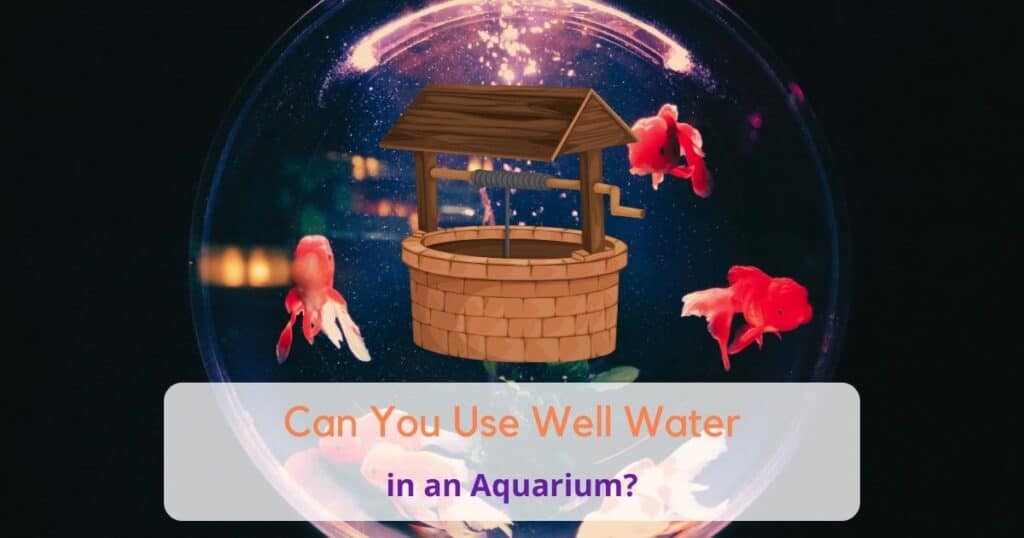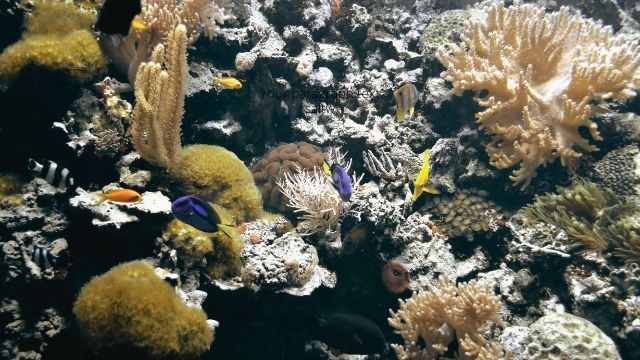
Keeping fish is a relaxing hobby.
But choosing suitable water to fill your aquarium can be stressful; especially if your home uses well water, and you’re not sure what’s in it.
And if you’re anything like me, you’ll probably have a childhood goldfish disaster you can’t keep from popping into your head.

In this article, we’ll explore if you can use well water in a fish tank, considerations for different kinds of aquariums, how to test your well water, and the best ways to treat it.
Is Well Water Safe for Fish?
Well water is safe for fish if it’s free of harmful contaminants and meets the correct pH levels required for your tank type and fish species. Unlike municipal water, well water may contain nitrates, VOCs, and other agricultural or industrial runoffs. These contaminants can cause health issues to your fish.
Well water also often has unusually high mineral content (eg. hard water), and can also be low in oxygen. So it may require a softener, or an aquarium filter pump for aeration before it’s safe for your new fish.
Test Your Water Before Using It in Your Fish Tank
Conducting regular testing is crucial to maintaining a healthy aquarium. You might think tap water or your local water supply is safe, but it could be filled with dangerous microorganisms and other chemicals.
Contaminant Testing
Get your water tested thoroughly before setting up the new tank
One of the most reliable testing kits on the market is distributed by MyTapScore. They have several options for evaluating well water, depending on severity.
We recommend their well water test kits to find out exactly what’s in your water.
pH Testing
Once you’ve tested for contaminants, industry experts say you must check the pH levels every two to three days. The same holds true when you introduce a new fish, or an old one dies. As soon as everything normalizes, you can reduce the time between testing to once a month.
A PH meter like this one distributed by Extenuating Threads is a fine choice. This model is incredibly accurate with a plus-minus rating of 0.01 and compact enough to carry around in your pocket. It’s perfect for evaluating aquarium, distilled, and other types of water.
pH test strips are another convenient way to test the water.

Freshwater Fish Tank vs. Saltwater Fish Tank
The type of aquarium you own at home will determine its water source and if any additional equipment is needed.
Fish in freshwater have very different needs than saltwater fish. Their bodies react distinctly to various levels of water hardness and chlorine.
Here are some important points to take note of in each situation.
Freshwater Tank
If you’re still considering what type of tank to build, you should know that freshwater is much easier to maintain. These fish are a lot less sensitive to contaminants. You’ll need to spend about thirty minutes weekly running basic tests.
It is important to note that increased Nitrate, Nitrite, and Ammonia levels can be dangerous for freshwater tanks. The levels of these contaminants can rise when we overfeed fish or residue of fish waste run-off.
Most freshwater fish do best in water with a pH level between 6.8 and 7.8. So keep a pH meter (like the one mentioned above) to hand to keep on top of this.
Saltwater Tank
The tank water in a saltwater setup is slightly more complicated. There are more types of microbes to watch out for. These include Chloramines, Chlorine, Phosphate, and other dissolved heavy metals.
You must also ensure enough minerals are present. Calcium and magnesium help facilitate coral growth and maintain the fluidity of surface water. These prevent clumps from forming around your pumps.
To ensure a healthy tank, use a reliable PH meter like the one we mentioned earlier. Use it to assess the caliber of softened water or when a salt mix or chlorine is added.

Other Well Contaminants to Watch Out For
Well water commonly contains other dangerous chemicals like Iron, Manganese, and other heavy metals. Excess chlorine may also be present if it’s added to the well as a treatment method.
Treating Well Water for Fish Tanks
To wrap up this article, here are a few options that may help you improve your well’s water for your fish to live in.
Use a Well Water Filter for Iron and Heavy Metals
Well water is often filled with different heavy metals and contaminants. The first step to getting well water ready for use in an aquarium would be to install a well water filter. These automatically remove harmful contaminants without much effort.
Another advantage of a well water filter is that you’ll also have clean water for drinking, washing, bathing, and laundry!
Check out this buying guide on the best well water filters for iron, manganese, and other common well water contaminants.
Invest in a Reverse Osmosis and Deionization System (RO/DI)
The gold standard for treating water for fish tanks is using an RO/DI combination. Which is using reverse osmosis filters in combination with a deionizer.
The first step is RO which removes contaminants by pushing them through a membrane. Reverse osmosis water removes between 95 and 99% of contaminants.
The second stage is a deionizer. A deionizer utilizes positive and negative charges to eliminate the last remaining microorganisms to purify the water. This method creates deionized water that is as clean as bottled water.
As it’s the ‘gold standard’ for fish tanks, an RO/DI system doesn’t come without a price tag. But those without a big budget can likewise go for a simple solution. Adding baking soda to city water acts as a water conditioner. This method remineralizes the aquarium, creating a healthy environment for your fish.
Don’t forget to remineralize
When using RO/DI or even distilled water for your aquarium water, all of the beneficial minerals are removed. So don’t forget to remineralize distilled water to the recommended levels.
Some ways of doing this include:
- Adding a remineralizing cartridge to your water filter
- Adding an off the shelf remineralizing formula from your local fish store
- Making your own remineralizer from baking soda, conditioner, and acid buffer
Don’t tank your aquarium
Well water may contain harmful chemicals that are not safe for fish. As such, we recommend doing the basic maintenance practices to ensure everything is running smoothly.
Make sure to use a PH meter to gauge the water quality monthly. An iron filter is helpful, too, to control the amount of heavy metals in your tank, while a reverse osmosis and deionization system (RO/DI) removes any final harmful contaminants.
